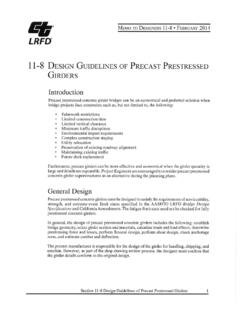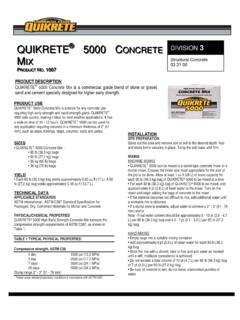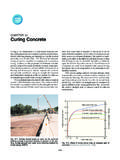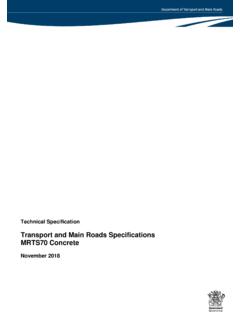Transcription of COLD WEATHER CONCRETE GUIDE FOR STRUCTURAL …
1 800-CEMSTONE | A cold WEATHER CONCRETE PLANRECOMMENDED CONCRETE TEMPERATURES & CURING DURATIONPRE-PLACEMENT, TEMPERATURE, HEATED ENCLOSURE CONCRETE MIXTURE, SLAB FINISHING & CURINGTEN cold WEATHER TIPS1234 cold WEATHER CONCRETE GUIDE FORSTRUCTURAL CONCRETEENGINEERING SERVICES The American CONCRETE Institute (ACI) 306R-16 GUIDE to cold WEATHER Concreting states that cold WEATHER concreting exists when the air temperature has fallen to or is expected to fall below 40 F during the protection period. The protection period is defined as the amount of time recommended to prevent CONCRETE from being adversely affected by exposure to cold WEATHER during construction. During the fall and winter seasons, ACI 306R-16 recommends that a cold WEATHER concreting plan be implemented for every CONCRETE placement.
2 The goal of this plan is to prevent the CONCRETE from being adversely affected by exposure to cold WEATHER during construction. The time to accomplish this is called the protection period. The following is a list of principles from ACI 306R-16 that should be considered when developing of a cold WEATHER CONCRETE plan: CONCRETE protected from freezing until it attains a compressive strength of at least 500 psi will not be damaged by exposure to a single freezing-and-thawing cycle (Powers, 1962). At 50 F, most well-proportioned CONCRETE mixtures reach this strength within 48 hours. Where a specified CONCRETE strength should be attained in a few days or weeks, planning (including mixture proportion alterations and revisions to construction practice) and protection could be required to maintain the CONCRETE temperature needed to attain the specified strength .
3 Except within heated protective enclosures, little or no external supply of moisture is recommended during cold WEATHER curing. Under certain conditions, calcium chloride (CaCl2) should not be used to accelerate setting and hardening because of increased chances of corrosion of metals embedded in CONCRETE . The use of non-chloride accelerators can be used in place of CaCl2 A cold WEATHER CONCRETING PLANACI 306R-16 lists the following objectives when creating a cold WEATHER CONCRETE plan: Prevent damage to CONCRETE due to freezing at early ages. See Table 1, Line 1 for the minimum CONCRETE placing temperature. Ensure that the CONCRETE develops the recommended strength for safe removal of formwork.
4 Maintain curing conditions that foster normal strength development without using water as a curing method. See Table 1, Lines 2-4. In addition, see Table 2 for the duration of the protection period. If the least dimension of the CONCRETE section is larger than 36 in., see Table Lines 2-4 of ACI 306R-16. Limit rapid temperature changes. Avoid cooling the CONCRETE too quickly and minimize temperature differences between the exterior and interior portions of STRUCTURAL members to reduce the likelihood of cracking which can lead to strength and durability issues. See Table 1, Line 5. If the least dimension of the CONCRETE section is larger than 36 in., see Table Line 5 of ACI 306R-16.
5 Provide protection consistent with intended serviceability of the structure. Surfaces, corners and edges need to be protected from freezing, dehydration, and cracking from overheating due to inadequate protection, improper curing, or careless PLACING SERVICET able 1 - Recommended CONCRETE temperaturesSection Size, minimum dimension<12 12 to 36 LineAir TemperatureMinimum CONCRETE temperature as placed and maintained1-55 F50 FMinimum CONCRETE temperature as mixed for the indicated air temperature*2 Above 30oF60 F55 F30 to 30oF65 F60 F4 Below 0oF70 F65 F5 Maximum allowable gradual temperature drop in the first 24 hours after end of protection50 F40 F* The contractor is responsible for informing Cemstone dispatch if higher CONCRETE temperatures are needed.
6 Additional costs may apply.* For colder WEATHER , a greater margin in temperature is provided between CONCRETE as mixed and required minimum temperature of fresh CONCRETE in 1: For Line 1, maximum placement temperature is minimum temperature in the table plus 20 F (11 C).Note 2: For Lines 2-4, maximum temperature is minimum temperature in the table plus 15 F (9 C).Note 3: For larger section sizes, consult Table of ACI Table ACI 306R-16 Table 2 Length of protection period for CONCRETE placed during cold weatherProtection period at a minimum temperature indicated in Line 1 of Table 1, days*Service ConditionNormal Set ConditionAccelerated Set ConcreteNo load, not exposed21No load, exposed32 Partial load, exposed64 Full loadRefer to Chapter 8 of ACI 306R-16* A day is a 24 hour period.
7 Ref. Table ACI 306R-16 RECOMMENDED CONCRETE TEMPERATURES & CURING DURATIONPRE-PLACEMENT, TEMPERATURE, HEATED ENCLOSURES CONCRETE MIXTURE, SLAB FINISHING & CURINGRECOMMENDATIONS PRE-PLACEMENT All formwork and subgrade should be free and clear of snow and ice. The temperature difference of the subgrade and fresh CONCRETE should be no greater than 20 F. When temperatures are below 10 F, metallic embeds should be warmed prior to placement. Embeds with larger cross- sections (4 in2 or greater) should be warmed to at least 32 F. Use heated enclosures, insulating blankets, insulation or other acceptable means for warming the subgrade and metallic embeds. TEMPERATURE During the spring and fall, not typically defined as cold WEATHER , protect CONCRETE surfaces from freezing for at least 24 hours or until the minimum compressive strength has been reached.
8 See Tables 1 and 2 for recommended protection temperatures and duration. When determining a protection plan, the surface temperature of the CONCRETE is the determining factor regardless of air temperature. Therefore: Monitor the surface temperature of the CONCRETE including corners and edges. Monitor the internal temperature to avoid excessive heating. Record the date and time at regular intervals as well as the maximum and minimum temperatures within a 24-hour period. Use CONCRETE maturity to determine the in-place compressive strength . HEATED ENCLOSURES Heated enclosures should be waterproof and strong enough to withstand anticipated winds and snow loads. Ensure corners and edges are sealed Combustion heaters should be vented to avoid exposing surfaces to carbon dioxide (CO2).
9 CO2 exposure can lead to crazing and carbonation. CONCRETE MIXTURES The water-cementitious materials ratio (w/cm) should be not exceed the recommendations within ACI All CONCRETE that is subjected to freeze-thaw cycling while saturated in service should have a w/cm ratio no greater than Air-entrained CONCRETE should not be specified for hard-trowel slab construction. Use accelerating admixtures to increase the rate of hydration. Do not use calcium chloride (CaCl2) containing accelerators or admixtures for CONCRETE containing reinforcing steel as this can lead to corrosion. In addition, CaCl2 admixtures can cause the CONCRETE to darken. Accelerating admixtures are not anti-freezing agents. Limit the use of supplementary cementing materials (SCMs), fly ash and slag, when early strength development is required.
10 SLAB FINISHING The use of air-entrained CONCRETE is recommended for members that will be exposed to freeze-thaw cycling, when saturated, during construction after the protection period has ended. This applies to members that may not be exposed to freeze-thaw cycling in service. Avoid hard-trowel finishing air-entrained CONCRETE (3% or greater) as this can lead to surface blistering or other surface defects. Therefore, air-entrained CONCRETE should not be specified for hard-trowel slab construction. CURING Upon completion of finishing, CONCRETE should be protected from drying, evaporation of moisture should be prevented. Subsequently, since fresh CONCRETE is critically saturated, a drying period must occur after curing and before the CONCRETE is exposed to freezing temperatures.








